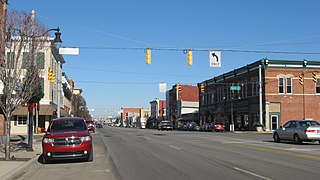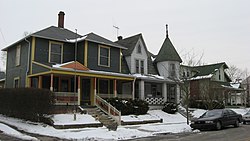
William Houston Craig House is a historic home located at Noblesville, Hamilton County, Indiana. It was built in 1893, and is a large 2 1/2-story, brick dwelling with Romanesque Revival and Queen Anne style design elements. It features multiple projections, porches, and a corner tower with rock faced stone details and contrasting textures and materials.

Daniel Craycraft House is a historic home located at Noblesville, Hamilton County, Indiana. It was built in 1892, and is a large 2 1/2-story, Queen Anne style frame dwelling. It features a three-story, square corner tower; cross-gables; steep gable-on-hip roof; porches and balconies; and contrasting textures and materials.

Dr. Samuel Harrell House, also known as the Harrell House, is a historic home located at Noblesville, Hamilton County, Indiana. It was built in 1898, and is a large 2 1/2-story, Queen Anne style frame dwelling. It features irregular massing; a three-story, polygonal corner tower; multi gable-on-hip roof; and wraparound porch. Also on the property is a contributing two-story, frame carriage house.

Judge Earl S. Stone House is a historic home located at Noblesville, Hamilton County, Indiana. It was built in 1849, and is a two-story, five bay, "L"-shaped, Greek Revival style brick dwelling. It is probably the oldest building in Noblesville.

Potter's Covered Bridge, also known as Potter's Bridge and Potter's Ford Bridge, is a historic covered bridge located in Potter's Bridge Park in Noblesville in Noblesville Township, Hamilton County, Indiana. It was built in 1871, and is a Howe truss structure measuring 260 feet long, 22 feet wide, and 20 feet tall. The single span bridge rests on limestone abutments and has walls clad in vertical board siding.

Holliday Hydroelectric Powerhouse and Dam, also known as Holliday Station, is a historic powerhouse and dam located on the White River near Noblesville in Noblesville Township, Hamilton County, Indiana. It was built in 1922, and includes a one-story Châteauesque style powerhouse building and a concrete dam measuring 10 feet high and 345 feet long. The powerhouse measures 26 feet wide and 40 feet long and is constructed of stone with a slate roof.

Noblesville Commercial Historic District is a national historic district located at Noblesville, Hamilton County, Indiana. It encompasses 54 contributing buildings in the central business district of Noblesville. It developed between about 1875 and 1931, and includes notable examples of Gothic Revival, Italianate, and Renaissance Revival style architecture. Located in the district is the separately listed Hamilton County Courthouse Square, which includes the courthouse (1877-1879) and Sheriff's Residence and Jail (1875). Other notable buildings include the Indiana Union Traction Company Station (1906), Lacy Block (1888), Evers Block (1889), U.S. Post Office (1906), U.S. Post Office (1931), and First Christian Church (1897-1898).

South 9th Street Historic District is a national historic district located at Noblesville, Hamilton County, Indiana. It encompasses 39 contributing buildings and 1 contributing site in a predominantly residential section of Noblesville. It developed between about 1860 and 1940, and includes notable examples of Queen Anne, Italianate, and Bungalow / American Craftsman style architecture. Notable buildings include the Masonic Temple and Adler Building.

Hamilton County Courthouse Square is a historic courthouse and jail located at Noblesville, Hamilton County, Indiana. The jail was built in 1875–1876, and is a Second Empire style brick and limestone building. It consists of the two-story, ell-shaped jailer's residence, with a cellblock attached at the rear. It features a three-story square tower that once had a mansard roof. The courthouse was built between 1877 and 1879, and is a three-story, Second Empire style, rectangular brick building. It has a clock tower atop the mansard roof and limestone Corinthian order pilasters.

Conner Street Historic District is a national historic district located at Noblesville, Hamilton County, Indiana. It encompasses 146 contributing buildings in a predominantly residential section of Noblesville. It developed between about 1840 and 1947, and includes notable examples of Queen Anne, Italianate, Colonial Revival, Classical Revival, and Bungalow / American Craftsman style architecture. Located in the district are the separately listed William Houston Craig House and Daniel Craycraft House. Other notable buildings include the Heylmann House, Gaeth House, Wild House, Noblesville High School Gymnasium, First Presbyterian Church, and Charles Swain House.

Noblesville Milling Company Mill, also known as the Model Mill, is a historic grinding mill located at Noblesville, Hamilton County, Indiana. The original section was built about 1872, and subsequently expanded to cover 1/2 a city block. It is a large brick structure, with the largest section being four stories tall. It includes a water tower built about 1903. It was originally built as a planing mill, but later converted to a grinding mill to produce flour.

Danville Main Street Historic District is a national historic district located at Danville, Hendricks County, Indiana. The district encompasses 42 contributing buildings and 2 contributing structures in the central business district of Danville. The district developed between about 1865 and 1960 and includes notable examples of Italianate, Classical Revival, Beaux-Arts, and Tudor Revival style architecture. Located in the district is the separately liste Hendricks County Jail and Sheriff's Residence. Other notable buildings include the Hall Block, Danville Public Library (1902-1903), Hendricks County Courthouse (1915), and Danville Post Office (1936).

Drover Town Historic District is a national historic district located at Huntington, Huntington County, Indiana. The district includes 231 contributing buildings, 2 contributing structures, and 1 contributing object in a predominantly residential section of Huntington. It developed between about 1857 and 1930 and includes notable examples of Federal, Greek Revival, Gothic Revival, Italianate, and Queen Anne style architecture. Located in the district are the separately listed German Reformed Church, Samuel Purviance House, and William Street School. Other notable buildings include the William Drover House, John Rhoads House (1896), and Griffiths Block (1896).

Portland Commercial Historic District is a national historic district located at Portland, Jay County, Indiana. It encompasses 58 contributing buildings, 1 contributing structure, and 1 contributing object in the central business district of Portland. The district developed between about 1870 and 1945, and includes notable examples of Italianate, Romanesque Revival, Classical Revival, and Early Commercial style architecture. Located in the district is the separately listed Jay County Courthouse. Other notable contributing resources include the U.S. Post Office (1914) designed by the Office of the Supervising Architect under Oscar Wenderoth, Portland Fire Station #1 (1929), Citizens Bank, FOE Eagles Lodge (1883), Johnson Building, Stevens Building (1910), Walnut Street Church of Christ (1913), and South Meridian Street Bridge (1914).

North Washington Street Historic District is a national historic district located in the city of Bloomington of Monroe County, Indiana. The district encompasses 35 contributing buildings and 6 contributing structures in a predominantly residential section of Bloomington. It developed between roughly 1870 and 1929, and includes notable examples of Queen Anne, Classical Revival, and Bungalow/American Craftsman style architecture. Located in the district is the separately listed Morgan House. Other notable buildings include the Showers-Graham House, Showers-Myers House, Teter House, and Washington Terrace Apartments (1929).

Highland Park Neighborhood Historic District is a national historic district located at Lafayette, Tippecanoe County, Indiana. The district encompasses 240 contributing buildings, 1 contributing site, and 1 contributing structure in a planned residential subdivision of Lafayette. It developed between about 1892 and 1945 and includes representative examples of Queen Anne, Tudor Revival, and Bungalow / American Craftsman style architecture. Notable contributing resources include the Blistain Axel Merritt House (1914), John Wagner Jr. House, John Ross House, and Bicycle Bridge (1924).

Ninth Street Hill Neighborhood Historic District is a national historic district located at Lafayette, Tippecanoe County, Indiana. The district encompasses 88 contributing buildings and 6 contributing structures in a predominantly residential section of Lafayette. It developed between about 1850 and 1946 and includes representative examples of Gothic Revival, Italianate, Queen Anne, Greek Revival, and Second Empire style architecture. Located in the district is the separately listed Judge Cyrus Ball House. Other notable contributing resources include the Samuel Moore House (1891), Moore-Porter-Boswell House (1895), Stanley Coulter House (1890), Edward Bohrer House (1909), Thomas Wood House, Job M. Nash House (1859), and Gordon Graham House.

North Meridian Street Historic District is a national historic district located at Indianapolis, Indiana. It encompasses 169 contributing buildings in a high style residential section of Indianapolis. The district developed between about 1900 and 1936, and includes representative examples of Tudor Revival, Colonial Revival, and Classical Revival style architecture. Located in the district is the separately listed William N. Thompson House. Other notable contributing resources include the Evan-Blankenbaker House (1901), Sears-Townsend House (1930), MacGill-Wemmer House, Hugh Love House (1930), Hare-Tarkington House (1911), Shea House (1922), and Brant-Weinhardt House (1932).

Washington Street–Monument Circle Historic District is a national historic district located at Indianapolis, Indiana. The district encompasses 40 contributing buildings and 2 contributing structures in the central business district of Indianapolis centered on Monument Circle. It developed between about 1852 and 1946, and includes representative examples of Italianate, Greek Revival, and Art Deco style architecture. Eighteen of the contributing buildings are individually listed on the National Register of Historic Places. Other notable buildings include the L.S. Ayres & Co. Department Store, Kahn Tailoring Company Building (1915), Hannaman and Duzan Building (1852), Odd Fellows Building (1907–1908), Hotel Harrison (1927–1928), Guaranty Building (1922–1923), Circle Tower (1929–1930), Consolidated Building (1909), and Turner Building and Savings Association (1941).

Shortridge–Meridian Street Apartments Historic District is a national historic district located at Indianapolis, Indiana. The district encompasses 136 contributing buildings in a predominantly residential section of Indianapolis. It was developed between about 1900 and 1951, and includes representative examples of Colonial Revival, Classical Revival, Late Gothic Revival, Mission Revival, Renaissance Revival, Bungalow / American Craftsman, and Art Deco style architecture. Located in the district is the separately listed Shortridge High School. Other notable buildings include the Vernon Court Apartments (1928), Fronenac Apartments (1951), Biltmore Apartments (1927), Meridian Apartments (1929), New Yorker Apartments (1917), Howland Manor (1929), Powell-Evans House (1911), Harms House (1906), Dorchester Apartments (1921), and Martin Manor Apartments (1916).
























